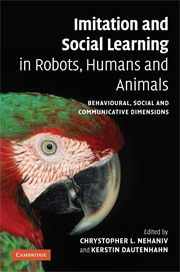 Imitation and Social Learning in Robots, Humans and Animals
Imitation and Social Learning in Robots, Humans and Animals Book contents
- Frontmatter
- Contents
- List of plates
- List of figures
- List of tables
- List of contributors
- Introduction: the constructive interdisciplinary viewpoint for understanding mechanisms and models of imitation and social learning
- Part I Correspondence problems and mechanisms
- Part II Mirroring and ‘mind-reading’
- Part III What to imitate?
- Part IV Development and embodiment
- Part V Synchrony and turn-taking as communicative mechanisms
- Part VI Why imitate? – Motivations
- 16 Multiple motivations for imitation in infancy
- 17 The progress drive hypothesis: an interpretation of early imitation
- Part VII Social feedback
- Part VIII The ecological context
- Index
- Plate section
- References
16 - Multiple motivations for imitation in infancy
Published online by Cambridge University Press: 10 December 2009
- Frontmatter
- Contents
- List of plates
- List of figures
- List of tables
- List of contributors
- Introduction: the constructive interdisciplinary viewpoint for understanding mechanisms and models of imitation and social learning
- Part I Correspondence problems and mechanisms
- Part II Mirroring and ‘mind-reading’
- Part III What to imitate?
- Part IV Development and embodiment
- Part V Synchrony and turn-taking as communicative mechanisms
- Part VI Why imitate? – Motivations
- 16 Multiple motivations for imitation in infancy
- 17 The progress drive hypothesis: an interpretation of early imitation
- Part VII Social feedback
- Part VIII The ecological context
- Index
- Plate section
- References
Summary
As the chapters in this book attest, during the last decade the study of imitation has become a topic of central importance through a diverse range of disciplines. There have been a greater number of controlled studies of imitation in non-human animals than ever before. Possible neural foundations of imitation have been identified. Encouraging progress has been made in developing imitation in constructed systems. Our understanding of the processes and mechanisms of imitation has been markedly advanced. Nonetheless, during this period most researchers have primarily focused on how imitation facilitates the acquisition of new skills or behaviours. In so doing, some important aspects of imitation have been neglected. In human development, infants imitate for a wide variety of reasons, both within and across different developmental stages and within and across different contexts. More specifically, for human infants imitation is an important form of pre-verbal communication that provides a means by which they can engage in social interaction. Our aim in this chapter is to provide an overview of the evidence that infants imitate not only to acquire new skills but also to engage socially with others, and this social engagement can itself take a number of different forms, with imitation being used flexibly as a means to various social ends.
Before going further a brief note on definition is warranted.
- Type
- Chapter
- Information
- Imitation and Social Learning in Robots, Humans and AnimalsBehavioural, Social and Communicative Dimensions, pp. 343 - 360Publisher: Cambridge University PressPrint publication year: 2007
References
- 4
- Cited by


